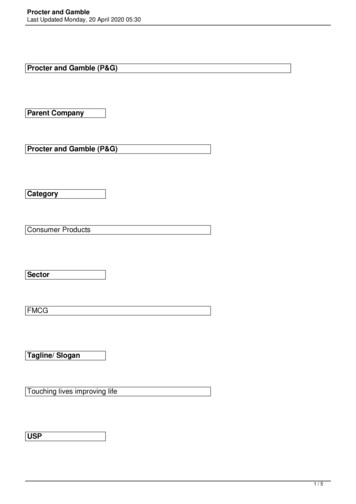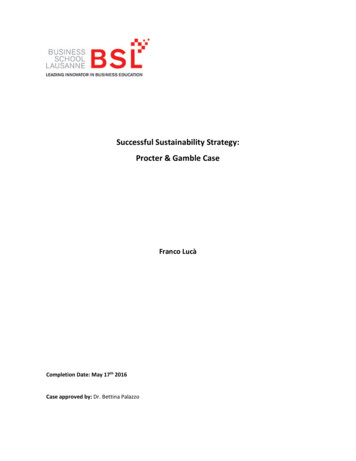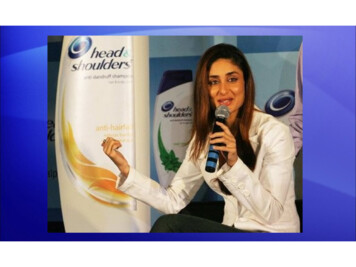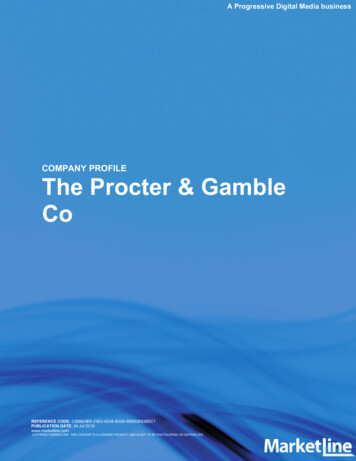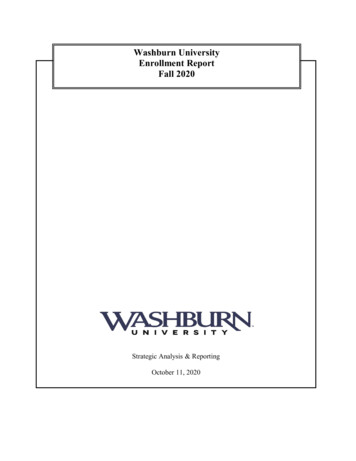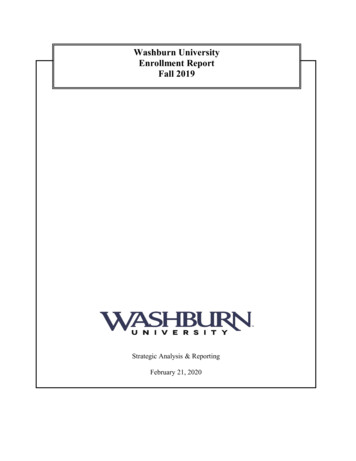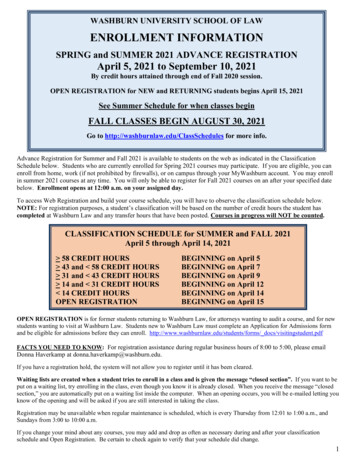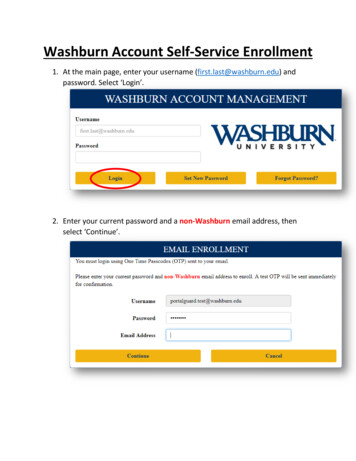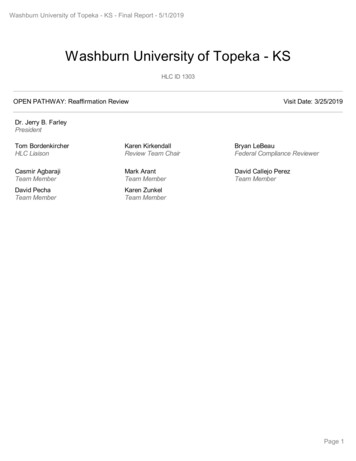
Transcription
Procter & GambleNYSE: PGStudent Investment Fund Stock ReportAnalysts: Janel Logan, Amanda Repp andPadma VenkatramanBusiness SummaryProcter & Gamble, founded in1837 and based in Cincinnati, OH,is recognized as the world's largestproducer and distributor ofhousehold and personal products.PG is organized into three globalbusiness units: Beauty; Health andWell‐Being; and Household Care.PG Procter and Gamble operatesin over 80 countries and offersproducts and services to morethan 180 countries worldwide. PGhas a strong global marketpresence. In 2009, PG generated61% of its total sales ininternational markets.Recommendation:Long Term BuyRecent Price (12/04/09): 62.60Sector: Consumer StaplesTarget Price:Sub‐Sector: Consumer Goods 65.5352‐Week Range: 43.93‐ 64.00Stock Classification: Classic GrowthMarket Capt:Institutional Ownership: 58%P/E Ratio:Earnings per Share: 178 B17.4 4.58Dividend Yield: 2.8%Beta: 0.6Price PerformanceHighlights PG is focused on developing itsconsumer understanding,marketing, and brand‐buildingtechniques. PG manages 23 brands thatindividually generate over 1billion in annual sales and 20brands that individually generatehalf of a billion in annual sales. 12 of PG’s billion‐dollar brands arecurrently the #1 global market shareleader in their respective productcategories.Investment Thesis Concerns over a sluggish economy in 2010 led us to PG — wefavor large‐capitalization, low beta, defensive stocks that payabove‐average dividends and have strong growth potential inforeign markets.PG is the best consumer staples stock in terms of brandmanagement, innovation and consumer understanding.Procter and Gamble has superior financial standing and hasprovided shareholders with substantial value creation over time.
Student Investment Fund:Procter & GambleBusiness SegmentsPG is organized into three global business units: Beauty, Health and Well‐Being, and Household Care. BEAUTY Includes two sub‐segments:o Beauty (2009 Sales 18.79 B, 23.7% of sales revenue) — cosmetics, deodorants, haircare, personal cleansing, prestige, fragrances and skin care products Billion‐dollar brands include: Head & Shoulders, Olay, Pantene and Wellao Grooming (2009 Sales 7.54 B, 9.54% of sales revenue) — blades and razors, electrichair removal devices, facial products, shave products and home appliances Billion‐dollar brands include: Braun, Fusion, Gillette and Mach 3 HEALTH AND WELL‐BEING Includes two sub‐segments:o Health Care (2009 Sales 13.62 B, 17.23% of sales revenue) — feminine care, oral careand personal health care products Billion‐dollar brandsinclude: Actonel,Always, Crest and Oral‐Bo Snacks and Pet Care (2009Sales 3.11 B, 3.94% of salesrevenue)—pet food and snacks Billon‐dollar brandsinclude: Iams andPringles HOUSEHOLD CARE Includes two sub‐segments:o Fabric Care and Home Care(2009 Sales 23.19 B, 29.33% ofsales revenue)—air care,batteries, dish care, fabric careand surface care Billion‐dollar brandsinclude: Ariel, Dawn, Downy, Duracell, Gain and Tideo Baby Care and Family Care (2009 Sales 14.10 B, 17.84% of sales revenue)—baby wipes,bath tissues, diapers, facial tissues and paper towels Billion‐dollar brands include: Bounty, Charmin and Pampers
Student Investment Fund:Procter & GambleBusiness DivesturesProcter and Gamble has recently divested two of its business segments in order to refocus on its core businesssegments and to continue to maintain its strong portfolio of brands. Folgers: On June 4, 2008, PG sold its Folgers coffee unit to J.M. Smucker Company in an all‐stock dealworth approximately 2.95 billion. Pharmaceuticals: In 2006, the company began winding down its discover‐phase pharmaceuticalproducts in favor of licensing late‐stage compounds, and announced in 2008 it would exit the drugindustry entirely. In 2009, PG sold its pharmaceutical unit to Warner Chilcott in a 3.1 billion cash deal.As a result of the divesture, Procter and Gamble expects to book a 43 cent per share earnings boost inthe second quarter of fiscal year 2010.These divestures will allow PG to primarily focus on its personal care, beauty, and household product divisions.Moreover, it is our assessment that these divestures reveal Procter and Gamble’s strong focus on maintaininga solid portfolio of brands that add value for the company rather than growing for growth's sake.Consistency in Top ManagementProcter and Gamble recently named Robert McDonald as president and CEO, succeeding A.G. Lafley, effectiveas of July 2009. The new CEO Robert McDonald, otherwise known as Bob McDonald, comes into the positionwith a rich company background. McDonald previously served as Vice Chair of PG’s Global Business Units andOperations. Furthermore, McDonald has vast experience in brand‐building and market development, and hasover 30 years of experience with Procter and Gamble.The news of Bob McDonald being named CEO of the company, shortly followed the announcement of PG’sCFO Clayt Daley’s retirement. Daley was replaced January 1, 2009 by Jon Moeller. Prior to accepting the newCFO position, Moeller previously served as the Vice President and Treasurer of Procter and Gamble. Moelleralso served as Vice President of Finance and Accounting in various global business units within the company.Similar to McDonald, Moeller has developed a rich history at Procter and Gamble.Looking forward, Procter and Gamble can remain confident in their recent changes in top management. Bothexecutive successors are individuals who have a thorough and well‐developed understanding of thecompany’s core businesses and international markets, gained through many years of experience with Procterand Gamble.
Student Investment Fund:Procter & GambleCompetitorsProcter and Gamble provides largest and broadest portfolio of products in the household and personal careindustry with 24 billion dollar brands. PG generates 43% more revenue than its closest competitor, Unilever(UL). PG also maintains a relatively high operating margin of 20.46% in 2009, the highest amongst itscompetitors. Moreover, the company invests more than 2 billion annually in Research and Development —nearly twice that of Unilever, and equal to the combined total of its other major competitors — Avon, CloroxCompany (CLX), Colgate‐Palmolive Company (CL), Energizer Holdings (ENR), Henkel, Kimberly‐Clark (KMB),L'Oreal, and Reckitt Benckiser.PROCTER &GAMBLEREVENUE(IN MILLIONS)NET INCOME(IN MILLIONS)OPERATINGMARGINDIVIDENDYIELD 79,029 11,01020.79%3.0%UNILEVER 56,546 7,015N/A1.38%CLOROXCOMPANY 5,440 56620.12%3.3%KIMBERLY –CLARK 18,730 ,181015.95%3.8%COLGATE –PALMOLIVE 1,4910 2,31022.68%2.2%BILLION DOLLAR BRAND(S)PAMPERS, PANTENE, CREST,TIDE, BOUNTY, DURACELL,CHARMINDOVE, AXE, LIPTON, VASELINE,SLIM‐FAST, BEN & JERRY’SCLOROX BLEACH, PINE‐SOL,GLAD, BRITA WATER FILTERS,BURT’S BEESHUGGIES, KLEENEX, SCOTTPAPER TOWELSCOLGATE TOOTHPASTE,PALMOLIVE DISHWASHINGLIQUID, SOFTSOAP, SPEEDSTICK
Student Investment Fund:Procter & GambleGlobal PresenceProcter and Gamble operates in over 80 countries and offers products and services in more than 180 countriesworldwide.Sales are divided into four main segments: North America accounted for 44% of total sales in 2009 or 34.8 billion. Western Europe accounted for 22% of total sales in 2009 or 17.4 billion. North East Asia accounted for 4% of total sales in 2009 or 3.2 billion. Developing Markets accounted for 30% of total sales in 2009 or 23.7 billion.
Student Investment Fund:Procter & GambleCurrently, international sales (sales outside of North America) generate roughly 61% of Procter and Gamble’stotal revenue. Over the past five years, the average growth rate for PG’s international sales was 12% — whichis almost three times that of PG’s domestic market sales growth of 5%.In recent years, Procter and Gamble has heavily penetrated developing markets. Developing markets includeLatin America, Central & Eastern Europe/Middle East and Africa, Greater China andASEAN/Australasia/India/Korea. Procter and Gamble’s sales in developing markets comprise 30% of its totalsales revenue‐‐ up a significant 20% since the beginning of the decade.International Market ShareProcter and Gamble maintains a strong focus on its market share, as this is a key factor for success in theConsumer Staples sector in which they compete in. Each firm must compete for market share and viability ofgrowing future sales for the company. As economies around the world continue to recover following theglobal downturn, Procter and Gamble recognizes that it is pertinent to have an established market share inorder to take advantage of new growth opportunities and increase their sales in the future.Developing markets currently make up 86% of the world’s population. Procter and Gamble has alreadyestablished a strong market share in the most crucial areas of these developing markets: Central & EasternEurope, Middle East & Africa Region, Latin America, Greater China and Developing Asia. It is important thatPG takes advantage of opportunities in these particular markets as these areas provide the largestinternational growth opportunities. Procter and Gamble has established themselves as the leader in marketshare in the Blades and Razors markets. They are also first and second in market share in the Shampoos andDiapers markets, respectively. Additionally, they maintain first, second and third market share positions in theLaundry, Feminine Care and Oral Care product markets, respectively.Purposed Inspired Macro Strategy for GrowthProcter and Gamble is taking a focused approachtowards its growth opportunities. PG looks togrow its leading, global brands and core categories.PG will achieve this by narrowing the focus of theirportfolio. The recent divesture of theirpharmaceutical business is just one example of howthey are narrowing their focus. This will allow PG tofocus more heavily on their 43 billion and half‐billion dollar brands that generate 85% of theirrevenues. Furthermore, focusing on the expansionof these 43 core brands into markets, where theyare currently underrepresented.Where to Play:1) Grow leading, global brands and corecategories2) Build business with underserved andunserved consumers3) Continue to grow and develop faster‐growing, structurally attractive businesses withglobal leadership potential
Student Investment Fund:Procter & GambleAnother focus for Procter and Gamble is on building its business through underserved and unservedconsumers. As previously mentioned, developing markets make up more than 86% of the world’s population.PG’s sales in developing markets totaled nearly 24 billion in 2009 — nearly five times greater than theiraverage competitor’s sales in developing markets. Procter and Gamble continues to aim towards growing itscurrent 19% share in developing markets. This allows an attractive opportunity for PG to further its growthoutreach. In a recent interview with Fortune Magazine, Procter and Gamble’s CEO Bob McDonald explainedthat the company currently serves approximately 3.84 billion of the world’s 7.5 billion total population.Moreover, McDonald expressed PG’s plans to add 1 billion more customers over the next five years.PG’s final strategy takes a focused approach towards growing structurally‐sound businesses, rather thangrowing for growth’s sake. The company maintains a solid strategy for future growth that adds value.Key Strategies for Success Consumer Understandingo Each year, Procter and Gamble interacts with nearly 5 million consumers in over 60 countriesworldwide.o It is important for Procter and Gamble to gain insight on consumer understanding in order todiscover innovation opportunities and to find ways in which the company can better serve itscustomers. It is especially important for PG to recognize and adjust to cultural differencesamong its international markets.Brand Buildingo Procter and Gamble currently has 23 brands within its product portfolio that individuallygenerate over one billion dollars in sales annually. PG also has 20 brands that generate half of abillion dollars in annual sales. Combined, these 43 brands account for 85% of PG’s total salesand 90% of PG’s profit. PG maintains the strongest‐performing portfolio of brands within itsindustry. Moreover, PG maintains its key competitive advantage for the overall success of thefirm.Innovationo Procter and Gamble is the industry leader in terms of innovation. Each year in the U.S., the IRINew Product Pacesetter Report ranks the best selling new products within the consumermarket. Over the past 14 years, Procter and Gamble has had 114 top 25 pacesetters—morethan six times the number of pacesetters of their largest competitors combined. (Pacesetter isdefined as a new, innovative Consumer Packaged Brand that exceeds 7.5 M in its first year).Established Go‐To‐Market Capabilityo Procter and Gamble is ranked as the preferred supplier and industry leader in a wide range ofcapabilities including clearest company strategy, brands most important to retailers, strongbusiness fundamentals and innovative marketing programs.Scaleo Procter and Gamble is able to take advantage of its ability to operate on a large scale. Thisallows PG to share processes and procedures among the categories under which they operate.This also creates the ability for PG to capitalize on its international expansion opportunitiessince they have the capabilities and resources for such ventures.
Student Investment Fund:Valuation AnalysisOur valuation analysis for PG was conducted usingconservative model assumptions. Our discountedcash flow model estimates PG’s intrinsic value at 65.53 per share for 2009, reaching 82.91 by 2019.Income Statement Inputs:Procter & GambleDividend Growth: Despite a solid historical year‐to‐year dividend growth rate of 16.9%, dividend growthhas been decreasing from its 2005 high of 37% growthto more moderate measures. Forecasted dividendgrowth was reduced to a level of 10% for the forecast.Balance Statement Inputs:Property, Pla
Purposed Inspired Macro Strategy for Growth Procter and Gamble is taking a focused approach towards its growth opportunities. PG looks to grow its leading, global brands and core categories. PG will achieve this by narrowing the focus of their portfolio. The recent divesture of their
